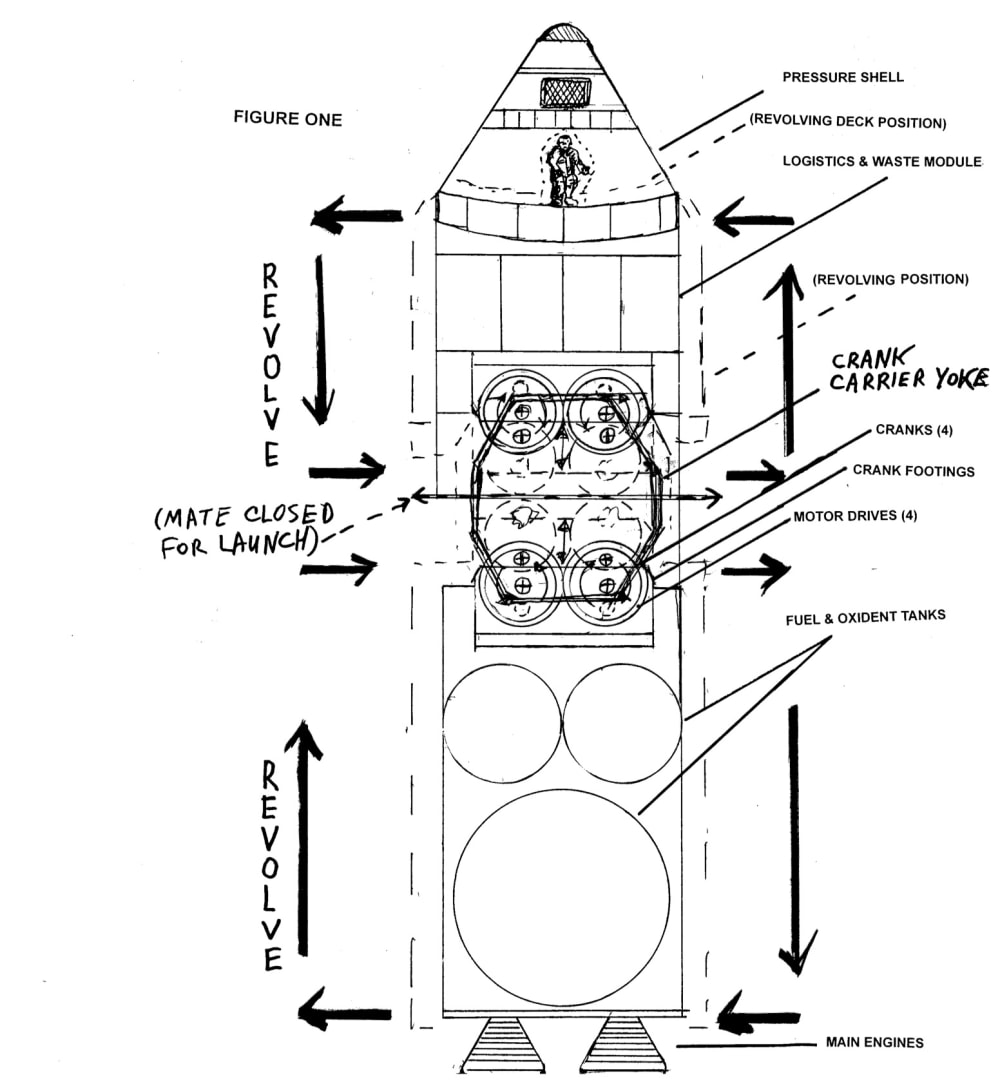A Mars spacecraft orbiter comprises a crew Habitat Block and a Service Propulsion Block, which are connected via a special crankset mechanism (Figure One) or else equivalent revolving means. The two halves revolve contrary to each other and act as counter-masses.
The Habitat is revolved to provide angular momentum-based "artificial gravity" for the benefit of the crew.
A theory of operation is that the decks will be spheric sections having a very large radius (CTF 2021). The revolving motion imparts angular momentum to the Habitat decks, as if it were a section of a very large radius sphere, moved like a lariat in an epicyclic pattern, rather than by legacy speculative concepts for rotating space stations.
An opposed crank embodiment comprises two sets of crank wheels driven by motor means. Cranks are linked by offset pins to a common Crank Carrier Yoke, which is like a sturdy machined plate or frame, perhaps comprising a carbon fiber and titanium sandwich. MagLev track means may replace the pins.
The Cranksets pull and push against the Crank Carrier Block, effectively reeling in and reeling out the two blocks of the vehicle, pulling them closer together and pushing them farther apart in an epicyclic pattern. As the cranks turn, they first draw the vehicle halves inward, pulling against the Yoke between them, then push them outward in a revolving motion.
The Habitat's motion is counterbalanced by that of its Propulsion block, revolving in the opposite direction. The whole vehicle is dynamically stabilized along it's trajectory line as it moves in and out upon itself, somewhat as a squid moves.
It may be feasible to orient crew decks parallel to the trajectory line, with the cranks installed on one edge rather than underneath the deck, but with equivalent motion.
It may be possible, given exterior contours, for crew to do extravehicular activities "walking on the roof" of the vehicle. Such a configuration may be scaled up to a very large crewed vehicle with many decks and work spaces (not pictured).
This innovative concept for artificial gravity may reduce Coriolis effects and allow more normal layout of decks, since the habitat stays oriented as it revolves through its cycle.
Crew transfer and utilities tunnels using revolving motion may be installed, in order to dock with away craft or to conduct extravehicular activities, as well as to maintain a continuous link with the power block for wet and dry transfer of fluids, power and data (CTF 2019).
The cranks may be locked in a close position so that the fore and aft halves of the vehicle may be mated together for launch and perhaps reentry and landing, as the case may be.
There could be broad commercial application to crewed spacecraft using revolving AG configurations, which may revolve the whole habitat externally, as above, or a free-floating deck structure internally (CTF 2021).
These building blocks may be applicable to both small and large vehicles for human spaceflight to the Moon, Mars and perhaps the stars.
Video
Like this entry?
-
About the Entrant
- Name:Leonard J Holmin
- Type of entry:individual
- Patent status:none

